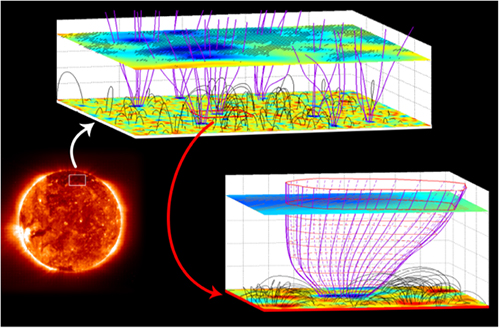The solar wind is a stream of plasma ejected from the upper atmosphere of the Sun, carrying the Sun's magnetic field through the heliosphere. The interaction of the solar wind and its transients with the Earth's magnetosphere and ionosphere strongly affects human activities both on Earth and in space. Since the discovery of the solar wind in 1962, its source and origin have been one of the outstanding problems in the solar and heliospheric physics, as well as one of the primary scientific objectives of many space missions. It can provide us crucial clues to understand the nature of many common phenomena in the universe such as magnetic reconnection, the stellar wind, etc.
To understand the origin of solar wind, we have achieved the following outstanding accomplishments: 1) the discovery of the dual characteristics (waves and turbulence) in the solar wind fluctuations, 2) the finding of the energy source of solar wind heating coming from the cascading energy of turbulence, and the establishment of a "WKB-like" theoretical model to self-consistently describe the turbulence transport and the solar wind heating, 3) the establishment of an extended intermittency model to explain the solar wind turbulence observations, 4) the discovery of the nascent solar wind originating from the transition region in the funnel-like flux tube, 5) the discovery of the two populations of kinetic waves in the solar wind turbulence at kinetic scales, 6) the discovery of the intermittent and high-speed network jet flow in the solar wind source region, 7) Identification of Alfvén wave excitation, propagation and damping in the solar wind source region. On these topics, we have published more than 100 SCI papers including one first-authored Research Article on SCIENCE magazine, and two academic monographs, with more than. 3000 SCI citations.

Fig. 1 Genesis of solar wind in coronal funnel.
References:
1.Tu C.-Y., The damping of interplanetary Alfvenic fluctuations and the heating of the solar wind, J. Geophys Res., vol.93, No.A1, p.7-20,1988
2.Tu, C. Y. and E. Marsch, A model of solar wind fluctuations with two components: Alfven waves and convective structures, J. Geophys. Res., 98, 1257—1276, 1993
3.Tu, C.Y., Structures, Waves, and Turbulence in Solar Wind, Space Sci. Rev., 73, 1—210, 1995
4.Tu, C.Y. and E. Marsch, Two-fluid model for heating of the solar corona and acceleration of the solar wind by high-frequency Alfven waves, Solar Phys., 171, 363—391, 1997
5.Tu, C.Y. and E. Marsch, On cyclotron wave heating and acceleration of solar wind ions in the outer corona, J. Geophys. Res., 106(A5), 8233—8252, 2001
6.Tu, C.-Y, C. Zhou, E. Marsch, L.D. Xia, L. Zhao et al, Solar wind origin in coronal funnels, Science, 308, 519-523, 2005
7.He, J.-S., Marsch, E., Tu, C.-Y., Tian, H., Excitation of Kink Waves Due to Small-Scale Magnetic Reconnection in the Chromosphere? ApJL, 705, 217-222, 2009.
8.He J-S, Marsch E, Tu C-Y, Yao S, Tian H. Possible Evidence of Alfvén-cyclotron Waves in the Angle Distribution of Magnetic Helicity of Solar Wind Turbulence. ApJ, 2011, 731, 85H, doi:10.1088/0004-637X/731/2/85.
9. Tian, H., DeLuca, E. E., Cranmer, S. R., et al., Prevalence of small-scale jets from the networks of the solar transition region and chromosphere, Science, 346, 1255711, 2014